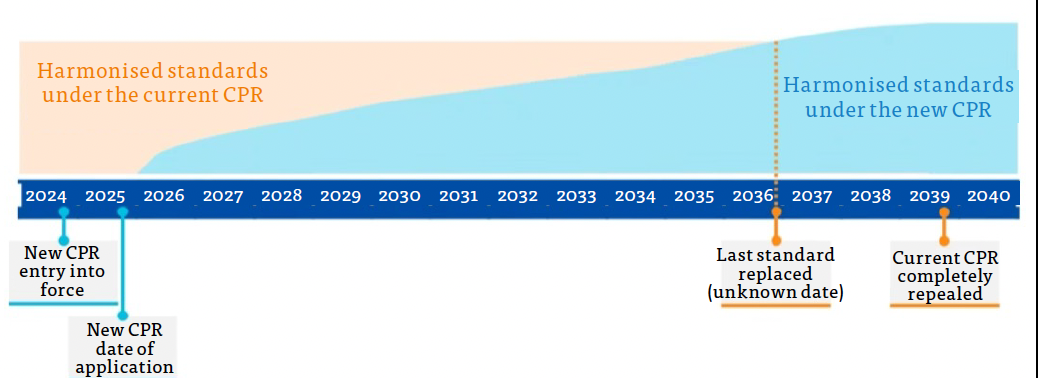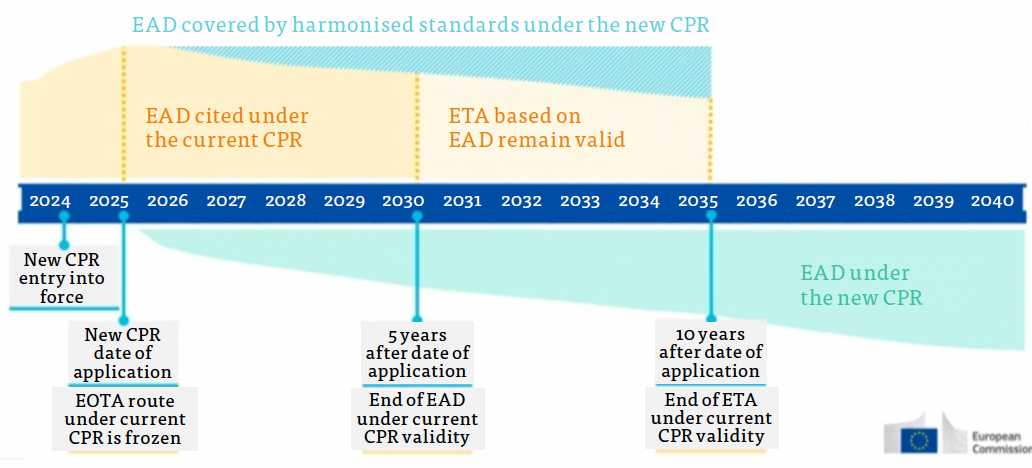
In this article U. Bourgund, T. Holland-Letz, T. Pregartner and M. Umminger of Construction Fixings Europe focus on the planned concept and timeline for the transition from the existing Construction Products Regulation to the new version, as well as the impact this could have on innovation within the construction sector.
On 10th April 2024 the European Commission (EC) published the result of the trilogue process (EU parliament, EU Council and EC) of a new Construction Product Regulation (CPR). The document covers all construction products specified on the basis of harmonised European Standards (hEN) and European Assessment Documents (EAD). 
The final CPR document is currently still to be translated into the Member States’ languages, which then is the basis for final voting in the EU parliament. Even though the final document is only expected in the second half of 2024, it can be assumed that the document will not see further changes – although technical errors are built in that jeopardise voluntary technical harmonisation at European level.
The intention of the CPR is to further develop the construction market in Europe towards more digital and environmentally friendly concepts, while maintaining a level playing field – therefore ensuring a high-level of harmonisation across Member States. Furthermore, it is hoped that the blockage in the publication process of European harmonised specification can be resolved at the same time.
One important achievement of the new CPR is that the route to CE Marking based on European Technical Assessments (ETA) for products or intended uses, which are not (fully) covered by a harmonised European Standard (hEN), is maintained.
The major pain point for the industry in the past has been the unpredictability of the publishing date of hEN and EAD, which leads to legal uncertainty; delays in the market introduction of new products; and the respective financial losses. The detailed needs from the industry on the general legal framework CPR has been discussed by some stakeholders in detail (e.g in a previous article in the September 2023 edition of
Fastener + Fixing Magazine[1]) but unfortunately are not reflected in the final CPR document.
For all products that are qualified and have mandatory CE Marking by hEN the transition to the new CPR legal framework is given in Figure One. The key message is straightforward, which means existing hEN are replaced continuously by newly revised hEN that are going to consider digital as well as sustainability characteristics. The final deadline is perceived as of 2039 when the current CPR is completely repealed.
For all products that are qualified on the basis of EADs/ETAs, and voluntary CE Marking, the transition to the new CPR legal framework will be organised in much shorter terms compared to hEN (Figure Two).
This means hEN based on the current CPR will remain valid until a new hEN based on the new CPR is published up until 2039. An EAD based on the current CPR will become invalid in 2030, even if no updated EAD is published.
Other key points to highlight are that with the date of application of the CPR being November 2025 the EOTA route is frozen. This most likely means after this point in time no EADs are going to be published that are developed on the basis of the current CPR. It is important to note that there are still a substantial number of EADs (24 EADs with 57 ETAs only in product area 33 ‘Fixings’ as per March 2024, 202 EADs ‘pending for citation’ in total) with issued ETAs, which according to the new CPR are pushed back into the ‘request’ status. So far, no information is provided on what ‘request status’ means in practical terms. This is another element to provide legal uncertainty to the construction industry.
There also seems to be a period of about five years where current EADs have to be reworked according to the new CPR requirements (sustainability, digital elements, etc). These EADs are then the basis for the respective voluntary ETAs that can be used for the newly created DoPC (Declaration of Performance and Conformity). Since the ownership of the EADs are with the EC and the EOTA, these tasks are to be handled with the respective resources in those organisations. The manufacturers have no role during this revision process. There is also the
intention to move a certain group of EADs into the area of hEN. Again the related concepts, mandates and resources are fully unclear.
On top of this, other sources from the EC clearly communicate that the delegated/implementing acts for for the sustainability requirements, as well as the digital concepts, will not be available for the first product families until 2027. This means in other words, at best the transition of current EADs into the frame of the new CPR (into revised EADs or new hEN) can only start from 2027, which means three years are left until the deadline of EADs in 2030.
Considering the existing number of EADs is around 400, and by observing that the EC and EOTA have been publishing about 20 to 30 EADs per year, the likelihood of having all existing EADs transfer into the new legal frame within three years (at best) is close to zero.
Beyond this, if we assume that innovation projects for new products in construction take about two years – and manufacturers usually start investing in innovative products only if it is absolutely clear how the performance of the final product is going to be identified – it could mean that from the date of application of the new CPR, in November 2025, investment in innovative product will stop until new EADs are published. As a consequence, investments in innovative products could stop in the construction sector for several years at European level.
In a nutshell, the fastener industry fears the following consequences as a result of the new CPR:
The European construction industry is in a difficult phase – triggered by material prices increase, raised interest rates for loans, etc. In this situation additional changes towards sustainability and more digital concepts are needed with no doubts. A new CPR that stops the necessary investment into innovation by repealing the developed EADs, and not replacing them on time with revised ones, is difficult to sell and hard to understand. This could result in leading industry sectors in construction being severely damaged.
What is the reason for allowing the stream of hENs to be smoothly and continuously adapted to the new CPR while the voluntary EAD route (the one for innovative products and applications) is being disrupted? It is easy and sustainable to allow the EAD revisiting process (to satisfy the requirements from the new CPR) in a similar way like hEN.
Finally, the manufacturers need to find solutions to satisfy the customer needs for existing and new applications in the construction sector. Maybe the solution is to ignore the voluntary EAD route, the European ‘harmonisation’ legal framework and go back to Member States assessments for product qualification. At least this may result in transparency and predictability on an individual Member State level.
References
[1] Ulrich Bourgund, Thomas Holland-Letz: ‘Construction Product Regulation (CPR) Revision - possible challenges for the ETA route’, Fastener + Fixing Magazine, Issue 143, September 2023.
[2] European Commission: Information provided at the Eurogypsum meeting, 15th March 2024.
[3] Council of the European Union: Proposal for a Regulation of the European Parliament and of the Council laying down harmonised conditions for the marketing of construction products, amending Regulation (EU) 2019/1020 and repealing Regulation (EU) 305/2011, 5620/24, Brussels, 1st February 2024.

Will joined Fastener + Fixing Magazine in 2007 and over the last 15 years has experienced every facet of the fastener sector - interviewing key figures within the industry and visiting leading companies and exhibitions around the globe.
Will manages the content strategy across all platforms and is the guardian for the high editorial standards that the Magazine is renowned.
Don't have an account? Sign Up
Signing up to Fastener + Fixing Magazine enables you to manage your account details.